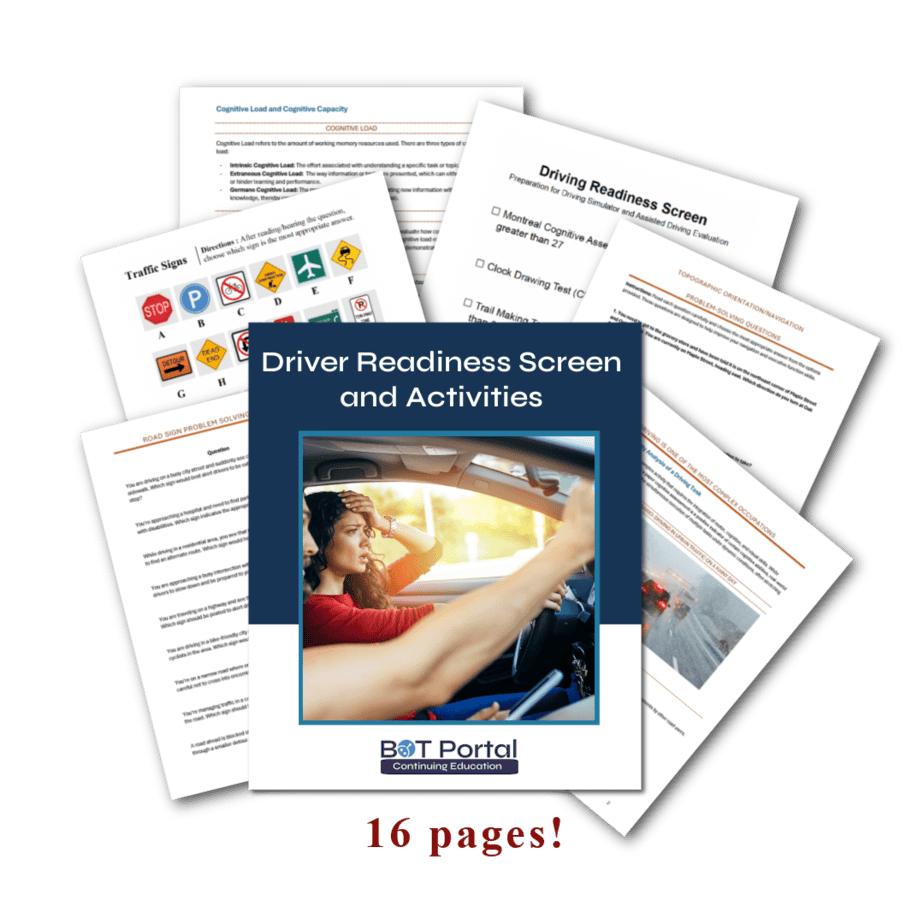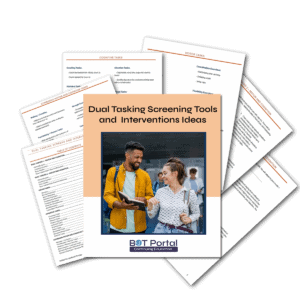Description
Driver Readiness Screen and Activities for Rehab
Driver Readiness Screen and Activities can be used to prepare your patient to see a Certified Driver Rehabilitation Specialist (CDRS)
Occupational therapy practitioners working with individuals who have executive function deficits must deeply understand the complexities of cognitive load, cognitive capacity, and cognitive reserve. These concepts are crucial in developing effective interventions that enhance occupational performance, particularly in tasks requiring high cognitive and motor demands, such as driving. This pack of information provides essential insights and tools to help practitioners address these challenges comprehensively.
Cognitive Load and Capacity
Cognitive load refers to the amount of working memory resources used during task performance. It encompasses intrinsic load (the effort required by the task itself), extraneous load (how the task is presented), and germane load (the effort to create long-term knowledge structures). In the context of dual-task activities like driving, these loads can quickly exceed an individual’s cognitive capacity, leading to decreased performance. Understanding these concepts allows occupational therapists to design interventions that manage cognitive load effectively, ensuring tasks are presented in ways that minimize unnecessary strain and facilitate learning and performance.
For instance, when rehabilitating a client for driving, an occupational therapist can simplify tasks and gradually introduce complexity to match the client’s cognitive capacity. This step-by-step approach helps avoid overwhelming the client and supports the development of necessary skills without exceeding their cognitive limits.
Cognitive Reserve
Cognitive reserve is a theoretical concept describing how individuals vary in their resilience to cognitive decline due to brain disease or aging. It represents the accumulated mental abilities developed over a lifetime, which can protect against cognitive losses. Recognizing the role of cognitive reserve in occupational performance is vital for practitioners working with clients experiencing executive function deficits. Those with higher cognitive reserve can better manage complex tasks and recover from disruptions, such as unexpected changes in driving conditions.
By understanding cognitive reserve, occupational therapists can tailor their interventions to leverage the client’s existing strengths. For example, they can engage clients in activities that stimulate cognitive functions and build upon their pre-existing skills, thereby enhancing their ability to perform complex occupational tasks.
Practical Application in Occupational Therapy
Driving is a prime example of an occupation that demands significant cognitive, motor, and visual integration. This pack of information equips occupational therapists with the knowledge to break down the dual-tasking complexities involved in driving. It emphasizes the importance of assessing and training cognitive load management, motor coordination, and visual processing.
Therapists can use scenarios and problem-solving questions to simulate real-world driving challenges, helping clients practice and improve their responses. This approach not only enhances cognitive and motor skills but also builds confidence in the client’s ability to handle complex tasks. By incorporating these principles, therapists can better prepare clients for safe and effective driving, ultimately improving their independence and quality of life.
What is included?
16-page activity packet that includes an explanation of dual tasking and why driving is so complex for the brain, traffic sign activity, questions and answers, and multiple-choice problem-solving questions for extrapolation and critical thinking.




